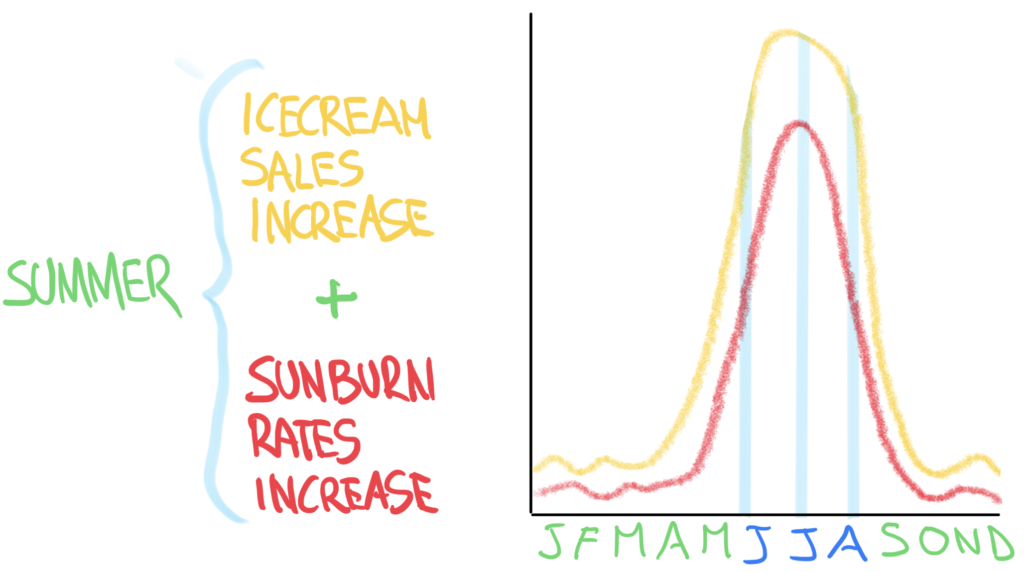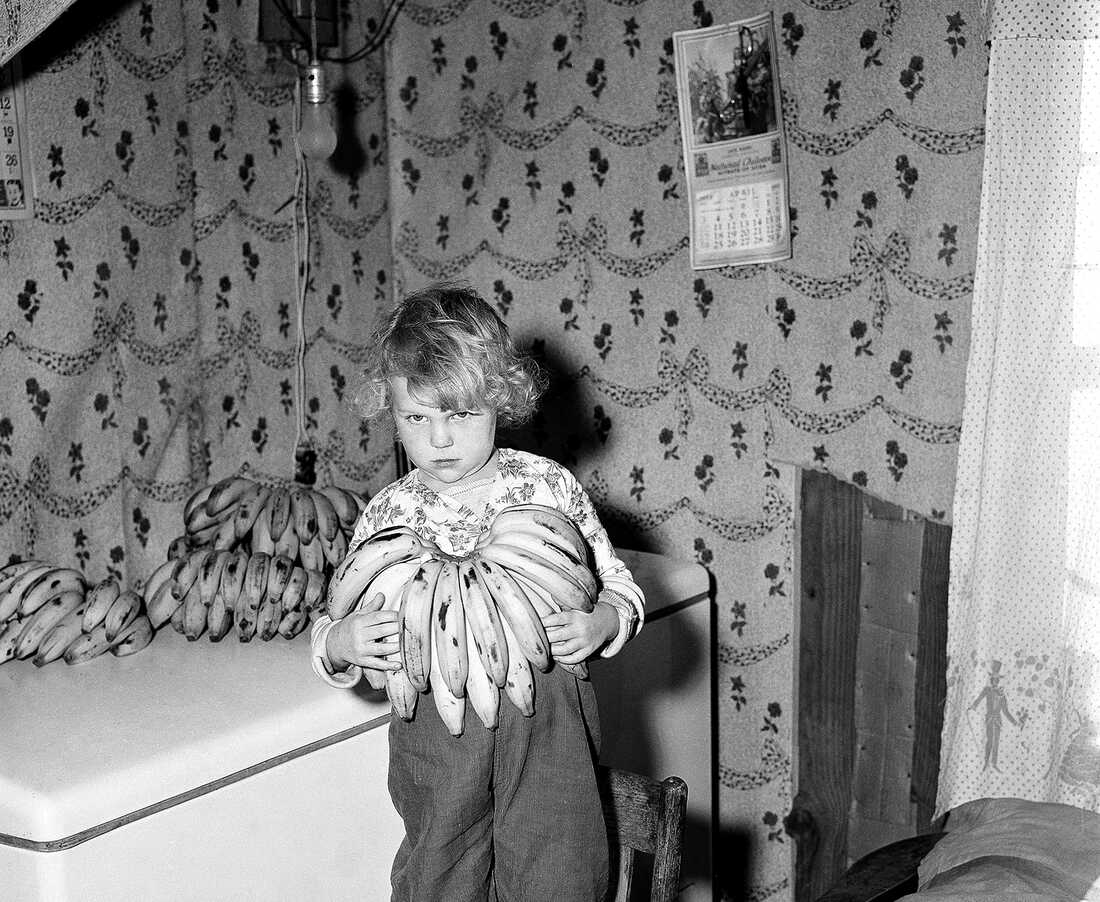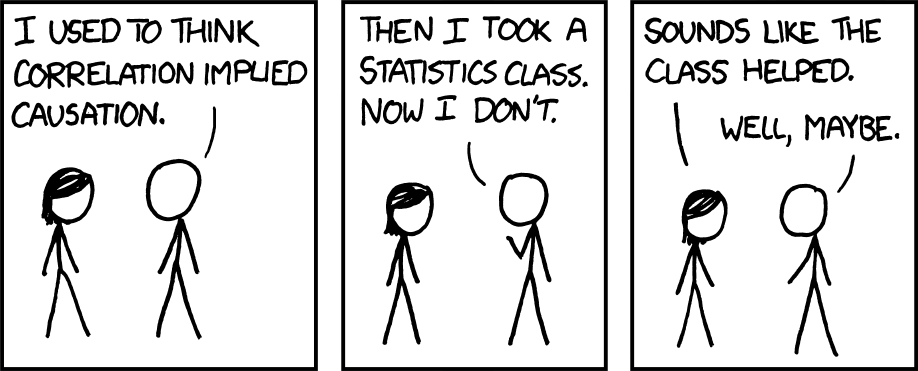One of my favourite cognitive biases is one that we come across very often, regardless if we analyze data or we simply live our lives without even skratching a bit of dataset. The illusion of causality consists of overestimating the degree of causality between two events, or even believing that two events are causally related when they are not. This bias has serious implications in that it promotes decisions which are based on illusory causal relationships.
A simple example you can find searching the web is the icecream example: looking at the data we can see that in the summer there is a peak in the sales of icecream cones, as well as an increase of sunburn rates. Does it mean that icecream eating increases the risk of getting a sunburn?

How often have we read the phrase “a study has proven that…”? Well that’s exactly what happens: a dataset is explored and sometimes a correlation is assumed to imply a cause-effect link that, in fact, does not exist. We are confusing correlation with causation (or causailty).
A couple of very good examples are “the banana causation” and “the black car causailty”. And as anticipated last week, today we’ll talk about bananas. Let’s go!
THE BANANAS DIET
The year was 1945, and 2-year-old Lindy Thomson had been given a few weeks to live. She suffered from diarrhea and projectile vomiting, and she was so thin and weak, she could no longer walk. Her parents had taken her from doctor to doctor. Finally, Dr. Douglas Arnold in Buffalo, N.Y., offered a most unusual prescription: She was to eat bananas.

“At least seven bananas a day,” recalls the patient, who now goes by her married name, Lindy Redmond. “To whom it may concern,” the doctor wrote on a prescription pad that Lindy still has as a keepsake. Lindy Thomson “has celiac disease (a nutritional disorder).”

Today we now know that celiac is an autoimmune disorder that strikes genetically predisposed people. It’s triggered by gluten in grains such as wheat, barley and rye. In the presence of gluten, the immune system of people with celiac disease attacks the small intestine, damaging the precious, fingerlike projections called villi that line it. This damage can lead to malnutrition, as well as a panoply of problems — from gas and bloating to fatigue, anemia, osteoporosis and an increased risk of certain cancers. The disease is estimated to affect 1 in 100 people worldwide. If left untreated (on a gluten-free diet) it leads to diarrhea, malabsorption, malnutrition and can be fatal.
But in 1924, decades before gluten was discovered to be the culprit, celiac disease was a black box of mystery. And the problem is that, until 1952, celiac disease was not associated with gluten. The children were sick, wasting away, and no one knew why; about 30% died at an early age. In 1924, however, a hope came to the patients’ families: the banana diet.
It was invented by Sidney Haas, a doctor from New York, based on his observation: in Puerto Rico celiac disease affected mainly the inhabitants of the cities, who ate a lot of bread, and spared those of the countryside, who had a diet based on bananas. Haas focused on the wrong detail: for him the point was the banana, not the bread.
And he started making patients eat abnormal amounts … up to 200 bananas in just one week. On the other hand, that fruit was in vogue: it was a superfood, a bit like modern day goji berries. For a time, it was thought that it could cure everything.
Incredibly, the diet worked, but for the wrong reasons. To make room for caloric bananas, Haas banned starches and grains, and recommended milk, meat and vegetables instead. Removed bread and starchy foods, the children were better off and began to gain weight again (the trouble came later, if anything, when they tried to reintroduce wheat). “The diet was unintentionally gluten-free and also incredibly high in calories,” explains Tricia Thompson, founder of Gluten Free Watchdog. “It is incredible what the mothers and fathers did, going down to the docks to meet the ships and buy multiple bananas hanging on branches. So many people were so very grateful to him,” she says of Haas. “He saved their lives.”
Until the 1950s, the banana diet remained a life-saving therapy for young celiacs, and Haas became the hero of the parents of the sick. The banana diet became very popular, so much so that someone also tried to use it against diabetes (with much less exciting results). When the role of gluten in celiac disease became clear in 1952, Haas refused to believe it: he became a staunch opponent of the new theory. Only with bananas – he said – was the healing safe and lasting.
For thirty years, however, he helped save the lives of hundreds of children. And it is no small thing, succeeding with a mistake.
